Dumas, Kjeldahls method | Equation, Procedure, Calculation, Example - Estimation of nitrogen | 11th Chemistry : UNIT 11 : Fundamentals of Organic Chemistry
Chapter: 11th Chemistry : UNIT 11 : Fundamentals of Organic Chemistry
Estimation of nitrogen
Estimation of nitrogen:
There are two methods for the estimation of nitrogen in an organic compound. They are 1. Dumas method 2. Kjeldahls method
1. Dumas method:
This method is based upon the fact that nitrogenous compound when heated with cupric oxide in an atmosphere of CO2 yields free nitrogen. Thus
CX HY NZ + (2x + Y/2) CuO → x CO2 + Y/2 H2O + z/2 N2 + (2x + Y/2) Cu
Traces of oxide of nitrogen, which may be formed in some cases, are reduced to elemental nitrogen by passing over heated copper spiral.
The apparatus used in Dumas method consists of CO2 generator, combustion tube, Schiffs nitrometer. (Fig. 11.4)
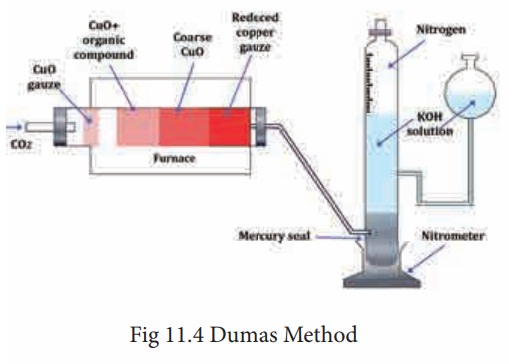
CO2 generator:
CO2 needed in this process is prepared by heating magnetite or sodium bicarbonate contained in a hard glass tube or by the action of dil. HCl on marble in a kipps apparatus. The gas is passed through the combustion tube after being dried by bubbling through Conc. H2SO4.
Combustion Tube:
The combustion tube is heated in a furnace is charged with a) A roll of oxidized copper gauze to prevent the back diffusion of the products of combustion and to heat the organic substance mixed with CuO by radiation b) a weighed amount of the organic substance mixed with excess of CuO, C) a layer of course CuO packed in about 2/3 of the entire length of the tube and kept in position by loose asbestos plug on either side; this oxidizes the organic vapors passing through it, and d) a reduced copper spiral which reduces any oxides of nitrogen formed during combustion to nitrogen.
Schiff’s nitro meter:
The nitrogen gas obtained by the decomposition of the substance in the combustion tube is mixed with considerable excess of CO2 It is estimated by passing nitrometer when CO2 is absorbed by KOH and the nitrogen gets collected in the upper part of graduated tube.
Procedure:
To start with the tap of nitro meter is left open. CO2 is passed through the combustion tube to expel the air in it. When the gas bubbles rising through, the potash solution fails to reach the top of it and is completely absorbed it shows that only CO2 is coming and that all air has been expelled from the combustion tube. The nitrometer is then filled with KOH solution by lowering the reservoir and the tap is closed. The combustion tube is now heated in the furnace and the temperature rises gradually. The nitrogen set free form the compound collects in the nitro meter. When the combustion is complete a strong current of CO2 is sent through, the apparatus in order to sweep the last trace of nitrogen from it. The volume of the gas gets collected is noted after adjusting the reservoir so that the solution in it and the graduated tube is the same. The atmospheric pressure and the temperature are also recorded.
Calculations:
Weight of the substance taken = wg
Volume of nitrogen = V1 L
Room Temperature = T1 K
Atmospheric Pressure = P mm of Hg
Agueen tension at
room temperature = P1 mm of Hg
Pressure of dry nitrogen = (P-P1) = P1 mm of Hg.
Let p0 V0 and T0 be the pressure, Volume and temperature respectively of dry nutrogen at STP,

Calculation of percentage of nitrogen. 22.4 L of N2 at STP weigh 28gof N2
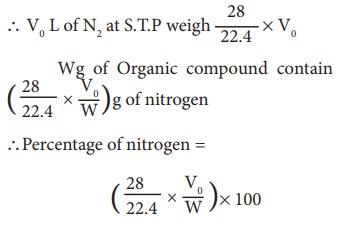
Example Problem:
0.1688 g when analyzed by the Dumas method yield 31.7 mL of moist nitrogen measured at 14º C and 758 mm mercury pressure. Determine the % of N in the substance (Aqueous tension at 14 º C =12 mm)
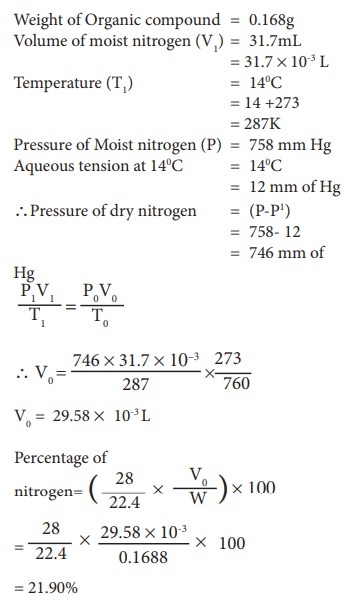
2. Kjeldahls method:
This method is carried much more easily than the Dumas method. It is used largely in the analysis of foods and fertilizers. Kjeldahls method is based on the fact that when an organic compound containing nitrogen is heated with Conc. H2SO4, the nitrogen in it is quantitatively converted to ammonium sulphate. The resultant liquid is then treated with excess of alkali and then liberated ammonia gas absorbed in excess of standard acid. The amount of ammonia (and hence nitrogen) is determined by finding the amount of acid neutralized by back titration with same standard alkali.
Procedure:
A weighed quantity of the substance (0.3 to 0.5 g) is placed in a special long – necked Kjeldahl flask made of pyrex glass. About 25 mL of Conc. H2SO4 together with a little K2SO4 and CuSO4 (catalyst) are added to it the flask is loosely stoppered by a glass bulb and heated gently in an inclined position. The heating is continued till the brown color of the liquid first produced, disappears leaving the contents clear as before. At this point all the nitrogen in the substance is converted to (NH4)2SO4. The Kjeldahl flask is then cooled and its contents are diluted with same distilled water and then carefully transferred into a 1 lit round bottom flask. An excess NaOH solution is poured down the side of the flask and it is fitted with a Kjeldahl trap and a water condenser. The lower end of the condenser dips in a measured volume of excess the N/20 H2SO4 solution. The liquid in the round bottom flask is then heated and the liberated ammonia is distilled into sulphuric acid. The Kjeldahl trap serves to retain any alkali splashed up on vigorous boiling. (Refer Fig. 11.3)
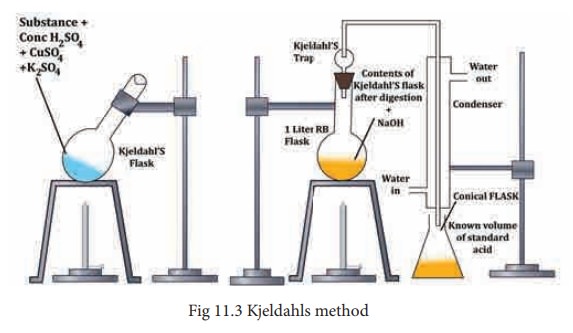
When no more ammonia passes over (test the distillate with red litmus) the receiver is removed. The excess of acid is then determined by titration with alkali, using phenolphthalein as the indicator.
Calculation:
Weight of the substance = Wg.
Volume of H2SO4 required for the complete neutralisation of evolved NH3 = V mL. Strength of H2SO4 used to neutralise NH3 = N
Let the Volume and the strength of NH3 formed are V1 and N1 respectively
we know that V1N1 = VN
The amount of nitrogen present in the w g
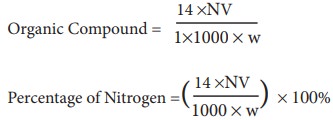
Example :
0.6 g of an organic compound was Kjeldalised and NH3 evolved was absorbed into 50 mL of semi-normal solution of H2SO4. The residual acid solution was diluted with distilled water and the volume made up to 150 mL. 20 mL of this diluted solution required 35 mL of N/20 NaOH solution for complete neutralization.
Calculate the % of N in the compound.
Weight of Organic compound = 0.6g
Volume of sulphuric acid taken = 50mL
Strength of sulphuric acid taken= 0.5 N
20 ml of diluted solution of unreacted sulphuric acid was neutralised by 35 mL of 0.05 N Sodium hydroxide
Strength of the diluted sulphuric acid = 35 × 0.05 / 20
= 0.0875 N
Volume of the sulphuric acid remaining after reaction with = V1 mL
Organic compound Strength of H2SO4 = 0.5N
Volume of the diluted H2SO4 = 150 mL
Strength of the diluted sulphuric acid = 0.0875 N
V1 = 150 ×0.087 / 0.5
= 26.25 mL
Volume of H2SO4 consumed by ammonia = 50 - 26.25 = 23.75 mL
23.75 mL of 0.5 N H2SO4 ≡ 23.75mL of 0.5N NH3
The amount of Nitrogen present in the 0.6 = 14g / [1000 mL × 1 N] × 23.75 × 0.5N = 0.166g
Percentage of Nitrogen = [0.166/0.6] × 100 = 27.66 %
Related Topics